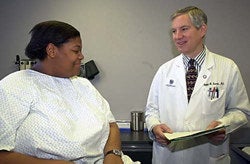ECU study shows sentinel node biopsy effective tool in breast cancer treatment
GREENVILLE, N.C. (Jan. 17, 2001) — Research at the Brody School of Medicine at East Carolina University and seven other medical centers published in this month’s edition of the Annals of Surgery reports positive findings in the use of sentinel node biopsy in the surgical treatment of breast cancer.

Mellissa Brown talks with Dr. Lannin. Photo by Cliff Hollis.
Sentinel node biopsy is a diagnostic tool cancer surgeons use to detect breast cancer metastases in the lymph nodes under the arm. The sentinel node is believed to be the first node cancer spreads to and is detected by injecting a small amount of blue dye and a radioactive tracer in and around the breast tumor. A hand-held Geiger counter follows the tracer to the sentinel node, which is then removed. Physicians examine the sentinel node to determine if the cancer has begun to spread, or metastasize, in the body. In identifying and removing the sentinel node, surgeons leave the surrounding lymph nodes intact. With traditional surgery, breast cancer patients undergo a more extensive dissection of axillary lymph nodes, which can lead to complications.
The sentinel node technique is hailed as one of the most exciting new approaches available to physicians as they try to develop more effective and less invasive methods for treating breast cancer.
Led by Dr. Lorraine Tafra, formerly with the Brody School of Medicine and now with Anne Arundel Medical Center in Annapolis, Md., and Dr. Donald Lannin of the Brody School of Medicine, the multicenter trial examined the factors associated with false-negative results on sentinel node biopsy and sentinel node localization. A false-negative result occurs when the sentinel node is found not to have cancer while another lymph node is determined to be cancerous through a more extensive lymph node dissection.
In the 27-month study, 529 patients underwent 535 sentinel node biopsy procedures with an overall rate in finding a sentinel node of 87 percent and a false-negative rate of 13 percent. Further analysis of the findings show that the success rate for the procedures improved after the surgeons had performed more than 30 cases and with younger breast cancer patients.
This study is a milestone for ECU and our cancer center, said Lannin, who is also medical director of the Leo W. Jenkins Cancer Center. In the past we have participated in many multicenter trials, but this is the first multicenter trial actually led by ECU cancer specialists. Our Comprehensive Breast Clinic is one of the four or five best in the country, and publication of this report in the most prestigious surgical journal certainly demonstrates our national leadership in breast cancer.
Before the surgical community jumps to using only sentinel node biopsy to locate the lymph nodes where the cancer has spread, the researchers say the surgeons must perform a thorough examination of the armpit area to decrease the false readings they might receive using sentinel node biopsy. Although it is not well established what false-negative rate, if any, will translate into decreased survival, the technique will spare more than half of patients an axillary node dissection, which carries significant complications and provides no benefit when the lymph nodes are negative, the researchers report in their conclusion.
The trial is continuing and Dr. Kathryn Verbanac, one of the ECU investigators, is using a $2 million grant to develop more sensitive methods for detecting cancer in the sentinel nodes.
The Annals of Surgery is the journal of the American Surgical Association.
Contact: Jeannine Hutson | 252-744-2481